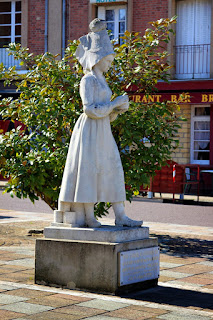 |
| Camembert de Normandie |
decade. Apparently it has become more difficult for cheesemakers to grow the key fungus needed to produce these cheeses. Over the years, the albino fungus has developed mutations which interfere with its normal ability to produce spores which makes it harder for the fungus to clone itself as Nature intended. The French National Centre for Scientific Research [CNRS] has published its Camembert research findings this week to general consternation. Camembert, for instance, is so quintessentially French that not only is it regarded as a national treasure it is also rumoured to be part of the DNA Francais! Its very name, the original Camembert de Normandie, is protected and is clearly defined as only made in certain regions with milk from specified heritage breed cows. Only then can the sacred name be used.
 |
| Statue of Marie Harel in Vimoutiers. The legend attributes invention of Camembert to Marie. |
The popular origin story is that Marie Harel, a farm woman from the Norman village of Camembert, first made the cheese in 1791 during the French Revolution. According to folklore, Marie provided shelter for a priest from Brie, home of a similar bloomy rind cheese, who was fleeing the Revolution. She was given the recipe in return for her good deed and she subsequently adapted the recipe to follow her region’s cheesemaking traditions. Historical records show that Marie existed and was indeed a farm woman from Camembert at the right time though there are no records to back up the date of 1791. However there are records to show that unique cheeses were being made in Camembert before Marie’s birth in 1761.
Marie’s descendants continued to use her name and her recipe to produce delicious cheese, and its fame spread ,the more so when a grandson provided Camembert to the grandson of Napoleon 111 in the 1860s. In the 1920s the producers of Camembert revived Marie’s story in its publicity material and in the Thirties, a statue of Marie was erected in Vimoutiers in hommage to her historical contribution to cheese-making. The CNRS is presently exploring plans to provide producers with slightly modified strains of the fungus through genome editing. It considers the fact that these special cheeses are increasingly produced by a few large manufacturers may inadvertently or otherwise, be affecting microbial diversity.
One of my earliest discoveries when I moved to Bury St Edmunds two years ago, was a Camembert-like cheese, complete with round box and milky rind, for sale locally; it is named Baron Bigod Brie. and I remember raving about it and suggesting it was even better than the French original! I have since discovered that it is made at Fen Farm Dairy in Bungay, Suffolk and the following is filleted from the publicity about this special cheese.
 |
| Herd of Monbeliarde cattle which produce milk perfect for Brie cheese-making. |
The actual result of all of this Suffolkian cheese activity, is poetry, not only in the above description, but also in the wonderful Baron Bigod Brie which emerges. In case of bewilderment, the difference between Brie and Camembert is outlined as follows:
Brie is typically aged for a longer period, around anywhere between five and ten weeks, which results in a mild and buttery flavour. Camembert, on the other hand, is aged for a slightly shorter period, usually around three to four weeks.
 |
| Fen Farm Dairy, Bungay, Suffolk. |
 |
| Le Moulin de Vimoutiers. |
 |
| Close-up of the famous statue of Marie Harel in Vimoutiers. She is attributed in the region with inventing Camembert. |





No comments:
Post a Comment